air condition PONTIAC G8 2008 Owners Manual
[x] Cancel search | Manufacturer: PONTIAC, Model Year: 2008, Model line: G8, Model: PONTIAC G8 2008Pages: 334, PDF Size: 2.99 MB
Page 19 of 334
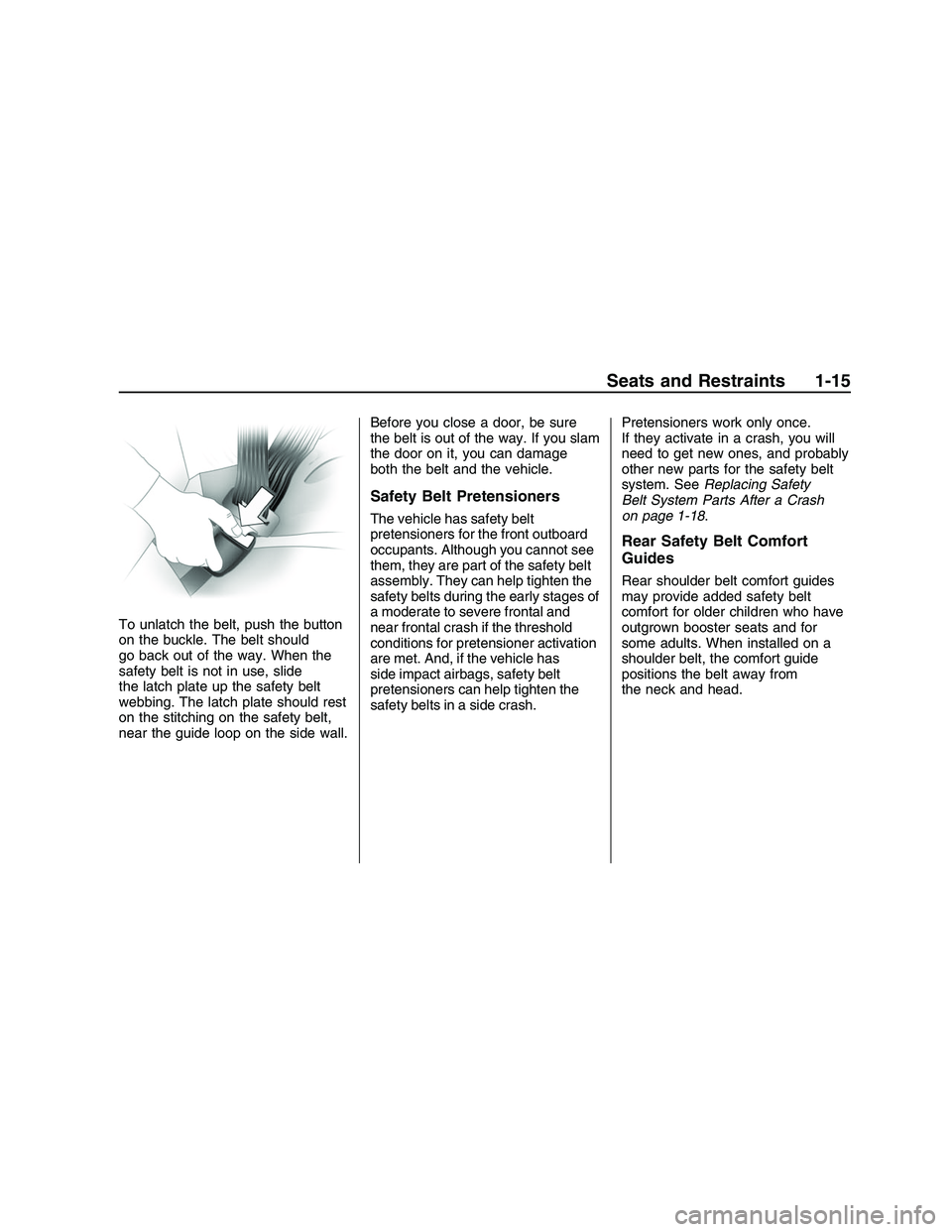
To unlatch the belt, push the button
on the buckle. The belt should
go back out of the way. When the
safety belt is not in use, slide
the latch plate up the safety belt
webbing. The latch plate should rest
on the stitching on the safety belt,
near the guide loop on the side wall.Before you close a door, be sure
the belt is out of the way. If you slam
the door on it, you can damage
both the belt and the vehicle.
Safety Belt Pretensioners
The vehicle has safety belt
pretensioners for the front outboard
occupants. Although you cannot see
them, they are part of the safety belt
assembly. They can help tighten the
safety belts during the early stages of
a moderate to severe frontal and
near frontal crash if the threshold
conditions for pretensioner activation
are met. And, if the vehicle has
side impact airbags, safety belt
pretensioners can help tighten the
safety belts in a side crash.Pretensioners work only once.
If they activate in a crash, you will
need to get new ones, and probably
other new parts for the safety belt
system. SeeReplacing Safety
Belt System Parts After a Crash
on page 1-18.
Rear Safety Belt Comfort
Guides
Rear shoulder belt comfort guides
may provide added safety belt
comfort for older children who have
outgrown booster seats and for
some adults. When installed on a
shoulder belt, the comfort guide
positions the belt away from
the neck and head.
Seats and Restraints 1-15
2008 - Pontiac G8 Owner Manual
Page 30 of 334
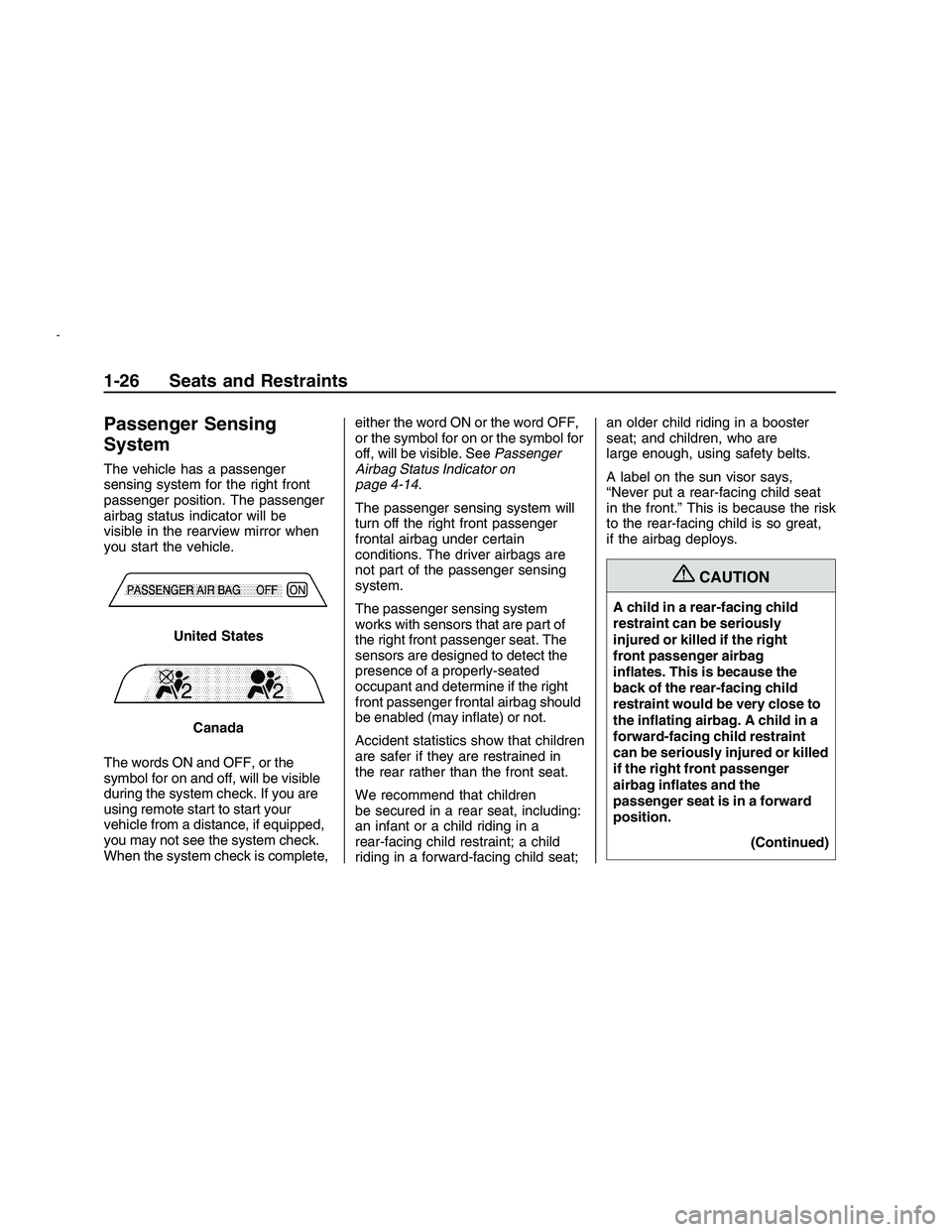
Passenger Sensing
System
The vehicle has a passenger
sensing system for the right front
passenger position. The passenger
airbag status indicator will be
visible in the rearview mirror when
you start the vehicle.
The words ON and OFF, or the
symbol for on and off, will be visible
during the system check. If you are
using remote start to start your
vehicle from a distance, if equipped,
you may not see the system check.
When the system check is complete,either the word ON or the word OFF,
or the symbol for on or the symbol for
off, will be visible. SeePassenger
Airbag Status Indicator on
page 4-14.
The passenger sensing system will
turn off the right front passenger
frontal airbag under certain
conditions. The driver airbags are
not part of the passenger sensing
system.
The passenger sensing system
works with sensors that are part of
the right front passenger seat. The
sensors are designed to detect the
presence of a properly-seated
occupant and determine if the right
front passenger frontal airbag should
be enabled (may in�ate) or not.
Accident statistics show that children
are safer if they are restrained in
the rear rather than the front seat.
We recommend that children
be secured in a rear seat, including:
an infant or a child riding in a
rear-facing child restraint; a child
riding in a forward-facing child seat;an older child riding in a booster
seat; and children, who are
large enough, using safety belts.
A label on the sun visor says,
“Never put a rear-facing child seat
in the front.” This is because the risk
to the rear-facing child is so great,
if the airbag deploys.
{CAUTION
A child in a rear-facing child
restraint can be seriously
injured or killed if the right
front passenger airbag
in�ates. This is because the
back of the rear-facing child
restraint would be very close to
the in�ating airbag. A child in a
forward-facing child restraint
can be seriously injured or killed
if the right front passenger
airbag in�ates and the
passenger seat is in a forward
position.
(Continued) United States
Canada
1-26 Seats and Restraints
2008 - Pontiac G8 Owner Manual
Page 52 of 334

Securing Child Restraints
(Right Front Seat)
This vehicle has airbags. A rear
seat is a safer place to secure
a forward-facing child restraint. See
Where to Put the Restraint on
page 1-38.
In addition, the vehicle has a
passenger sensing system which is
designed to turn off the right
front passenger frontal airbag under
certain conditions. SeePassenger
Sensing System on page 1-26
andPassenger Airbag Status
Indicator on page 4-14for more
information, including important
safety information.
A label on the sun visor says,
“Never put a rear-facing child seat
in the front.” This is because the risk
to the rear-facing child is so great,
if the airbag deploys.
{CAUTION
A child in a rear-facing child
restraint can be seriously
injured or killed if the right
front passenger airbag in�ates.
This is because the back of
the rear-facing child restraint
would be very close to the
in�ating airbag. A child in a
forward-facing child restraint
can be seriously injured
or killed if the right front
passenger airbag in�ates and
the passenger seat is in a
forward position.
Even if the passenger sensing
system has turned off the right
front passenger frontal airbag,
no system is fail-safe. No one
can guarantee that an airbag
will not deploy under some
unusual circumstance, even
though it is turned off.
(Continued)
CAUTION (Continued)
Secure rear-facing child
restraints in a rear seat, even if
the airbag is off. If you secure a
forward-facing child restraint in
the right front seat, always
move the front passenger seat
as far back as it will go. It is
better to secure the child
restraint in a rear seat.
SeePassenger Sensing System
on page 1-26for additional
information.
If the child restraint has the LATCH
system, seeLower Anchors and
Tethers for Children (LATCH)
on page 1-40for how to install the
child restraint using LATCH. If
you secure a child restraint using a
safety belt and it uses a top
tether, seeLower Anchors and
Tethers for Children (LATCH) on
page 1-40for top tether anchor
locations.
1-48 Seats and Restraints
2008 - Pontiac G8 Owner Manual
Page 90 of 334
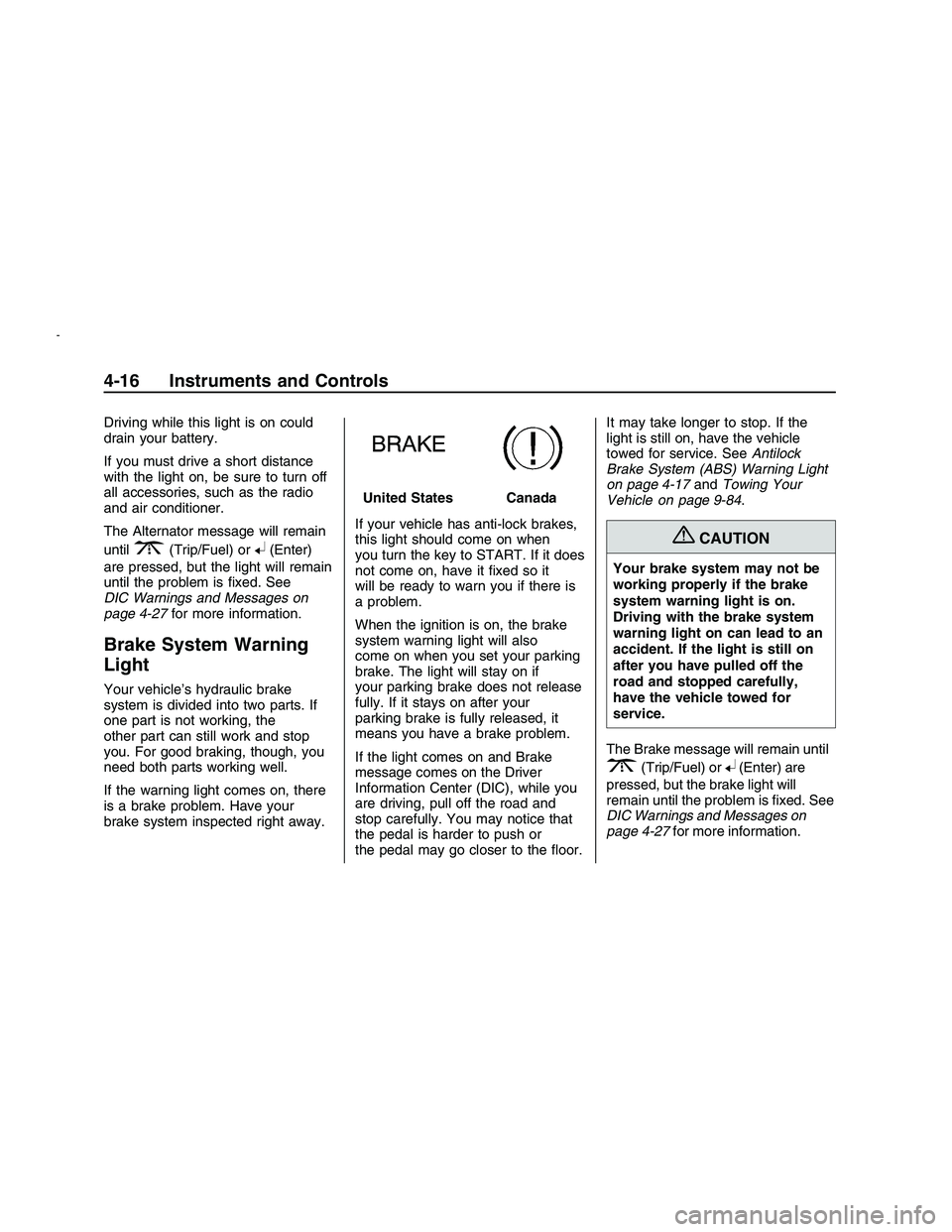
Driving while this light is on could
drain your battery.
If you must drive a short distance
with the light on, be sure to turn off
all accessories, such as the radio
and air conditioner.
The Alternator message will remain
until
3(Trip/Fuel) or8(Enter)
are pressed, but the light will remain
until the problem is �xed. See
DIC Warnings and Messages on
page 4-27for more information.
Brake System Warning
Light
Your vehicle’s hydraulic brake
system is divided into two parts. If
one part is not working, the
other part can still work and stop
you. For good braking, though, you
need both parts working well.
If the warning light comes on, there
is a brake problem. Have your
brake system inspected right away.If your vehicle has anti-lock brakes,
this light should come on when
you turn the key to START. If it does
not come on, have it �xed so it
will be ready to warn you if there is
a problem.
When the ignition is on, the brake
system warning light will also
come on when you set your parking
brake. The light will stay on if
your parking brake does not release
fully. If it stays on after your
parking brake is fully released, it
means you have a brake problem.
If the light comes on and Brake
message comes on the Driver
Information Center (DIC), while you
are driving, pull off the road and
stop carefully. You may notice that
the pedal is harder to push or
the pedal may go closer to the �oor.It may take longer to stop. If the
light is still on, have the vehicle
towed for service. SeeAntilock
Brake System (ABS) Warning Light
on page 4-17andTowing Your
Vehicle on page 9-84.
{CAUTION
Your brake system may not be
working properly if the brake
system warning light is on.
Driving with the brake system
warning light on can lead to an
accident. If the light is still on
after you have pulled off the
road and stopped carefully,
have the vehicle towed for
service.
The Brake message will remain until
3(Trip/Fuel) or8(Enter) are
pressed, but the brake light will
remain until the problem is �xed. See
DIC Warnings and Messages on
page 4-27for more information. United States
Canada
4-16 Instruments and Controls
2008 - Pontiac G8 Owner Manual
Page 93 of 334
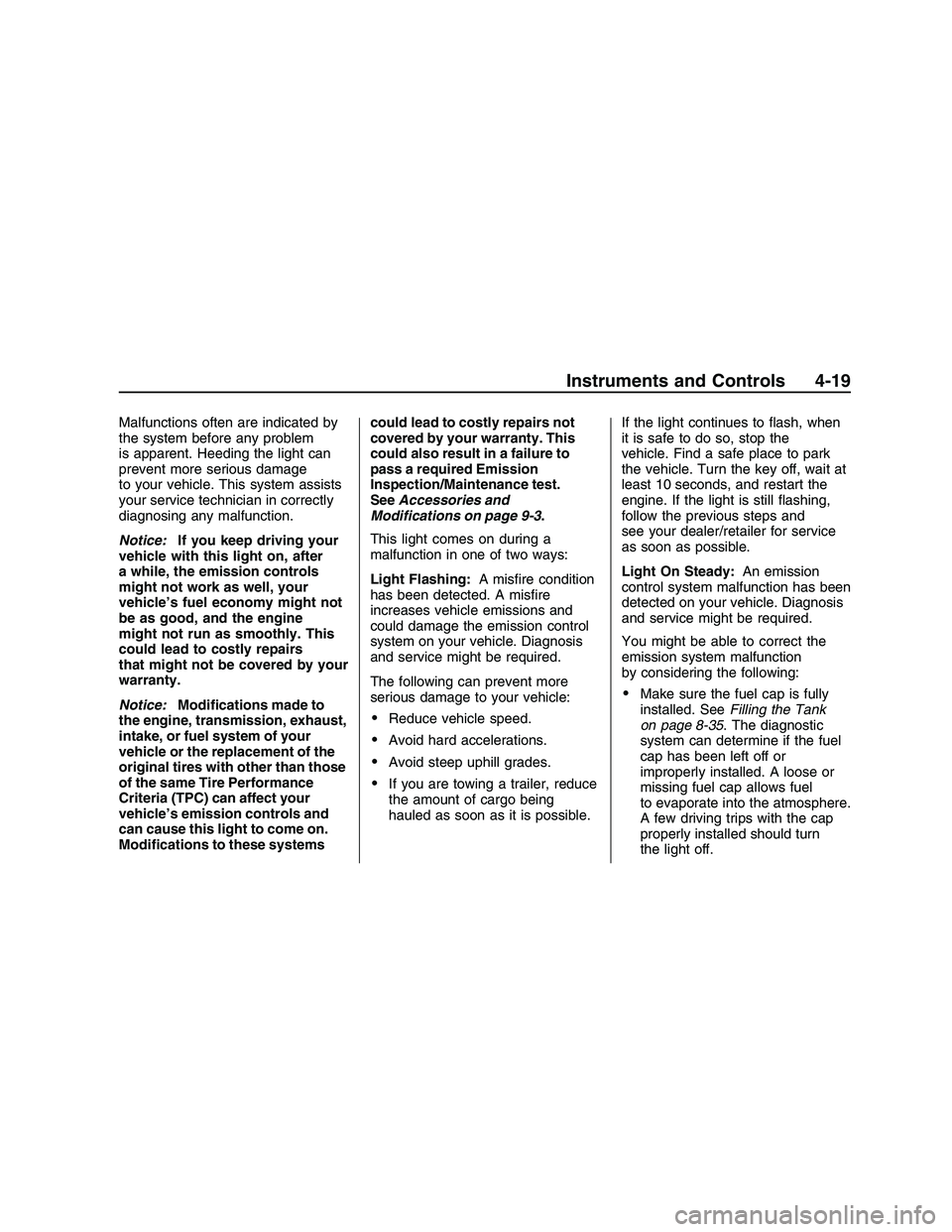
Malfunctions often are indicated by
the system before any problem
is apparent. Heeding the light can
prevent more serious damage
to your vehicle. This system assists
your service technician in correctly
diagnosing any malfunction.
Notice:If you keep driving your
vehicle with this light on, after
a while, the emission controls
might not work as well, your
vehicle’s fuel economy might not
be as good, and the engine
might not run as smoothly. This
could lead to costly repairs
that might not be covered by your
warranty.
Notice:Modi�cations made to
the engine, transmission, exhaust,
intake, or fuel system of your
vehicle or the replacement of the
original tires with other than those
of the same Tire Performance
Criteria (TPC) can affect your
vehicle’s emission controls and
can cause this light to come on.
Modi�cations to these systemscould lead to costly repairs not
covered by your warranty. This
could also result in a failure to
pass a required Emission
Inspection/Maintenance test.
SeeAccessories and
Modifications on page 9-3.
This light comes on during a
malfunction in one of two ways:
Light Flashing:A mis�re condition
has been detected. A mis�re
increases vehicle emissions and
could damage the emission control
system on your vehicle. Diagnosis
and service might be required.
The following can prevent more
serious damage to your vehicle:
Reduce vehicle speed.
Avoid hard accelerations.
Avoid steep uphill grades.
If you are towing a trailer, reduce
the amount of cargo being
hauled as soon as it is possible.If the light continues to �ash, when
it is safe to do so, stop the
vehicle. Find a safe place to park
the vehicle. Turn the key off, wait at
least 10 seconds, and restart the
engine. If the light is still �ashing,
follow the previous steps and
see your dealer/retailer for service
as soon as possible.
Light On Steady:An emission
control system malfunction has been
detected on your vehicle. Diagnosis
and service might be required.
You might be able to correct the
emission system malfunction
by considering the following:
Make sure the fuel cap is fully
installed. SeeFilling the Tank
on page 8-35. The diagnostic
system can determine if the fuel
cap has been left off or
improperly installed. A loose or
missing fuel cap allows fuel
to evaporate into the atmosphere.
A few driving trips with the cap
properly installed should turn
the light off.
Instruments and Controls 4-19
2008 - Pontiac G8 Owner Manual
Page 101 of 334
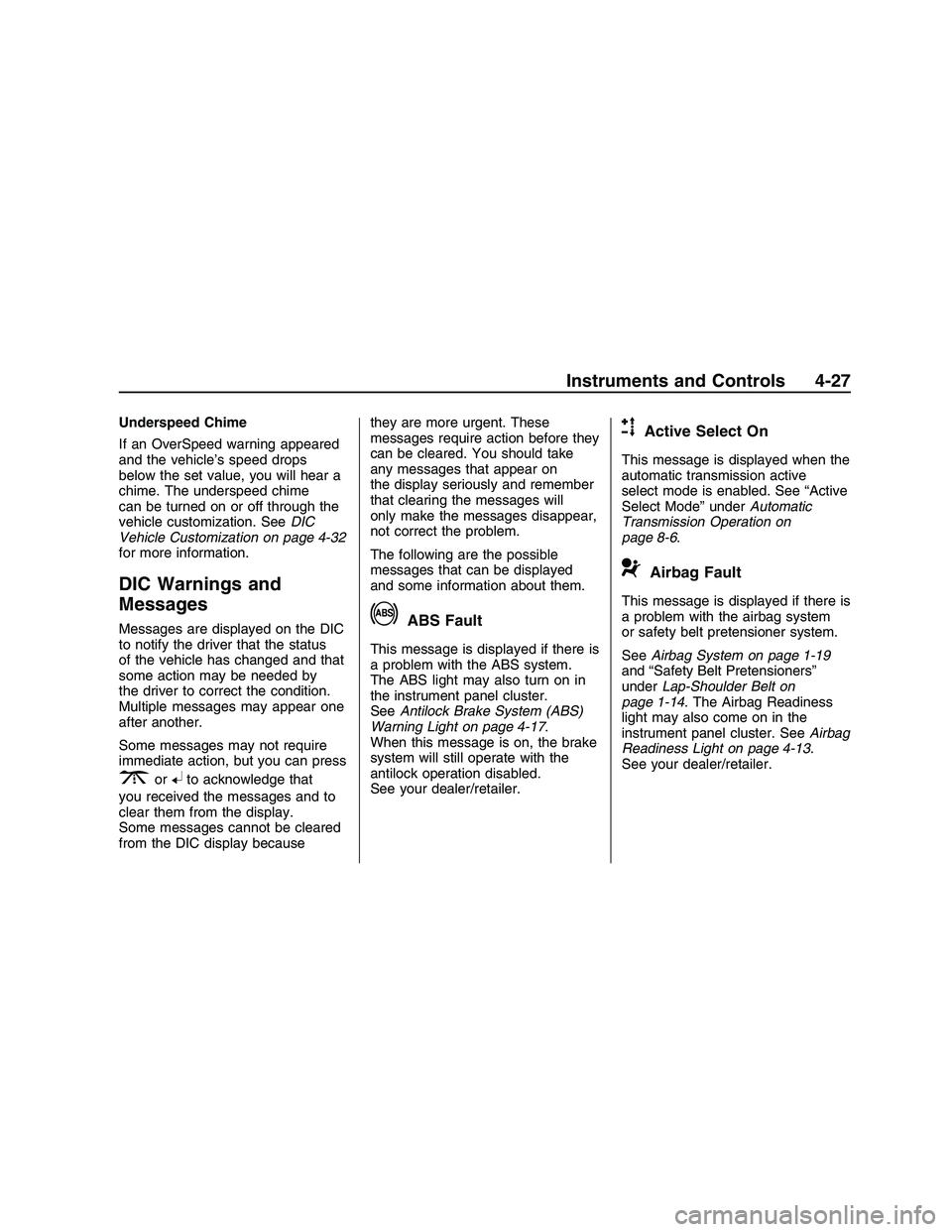
Underspeed Chime
If an OverSpeed warning appeared
and the vehicle’s speed drops
below the set value, you will hear a
chime. The underspeed chime
can be turned on or off through the
vehicle customization. SeeDIC
Vehicle Customization on page 4-32
for more information.
DIC Warnings and
Messages
Messages are displayed on the DIC
to notify the driver that the status
of the vehicle has changed and that
some action may be needed by
the driver to correct the condition.
Multiple messages may appear one
after another.
Some messages may not require
immediate action, but you can press
3or8to acknowledge that
you received the messages and to
clear them from the display.
Some messages cannot be cleared
from the DIC display becausethey are more urgent. These
messages require action before they
can be cleared. You should take
any messages that appear on
the display seriously and remember
that clearing the messages will
only make the messages disappear,
not correct the problem.
The following are the possible
messages that can be displayed
and some information about them.
!ABS Fault
This message is displayed if there is
a problem with the ABS system.
The ABS light may also turn on in
the instrument panel cluster.
SeeAntilock Brake System (ABS)
Warning Light on page 4-17.
When this message is on, the brake
system will still operate with the
antilock operation disabled.
See your dealer/retailer.
uActive Select On
This message is displayed when the
automatic transmission active
select mode is enabled. See “Active
Select Mode” underAutomatic
Transmission Operation on
page 8-6.
9Airbag Fault
This message is displayed if there is
a problem with the airbag system
or safety belt pretensioner system.
SeeAirbag System on page 1-19
and “Safety Belt Pretensioners”
underLap-Shoulder Belt on
page 1-14. The Airbag Readiness
light may also come on in the
instrument panel cluster. SeeAirbag
Readiness Light on page 4-13.
See your dealer/retailer.
Instruments and Controls 4-27
2008 - Pontiac G8 Owner Manual
Page 110 of 334
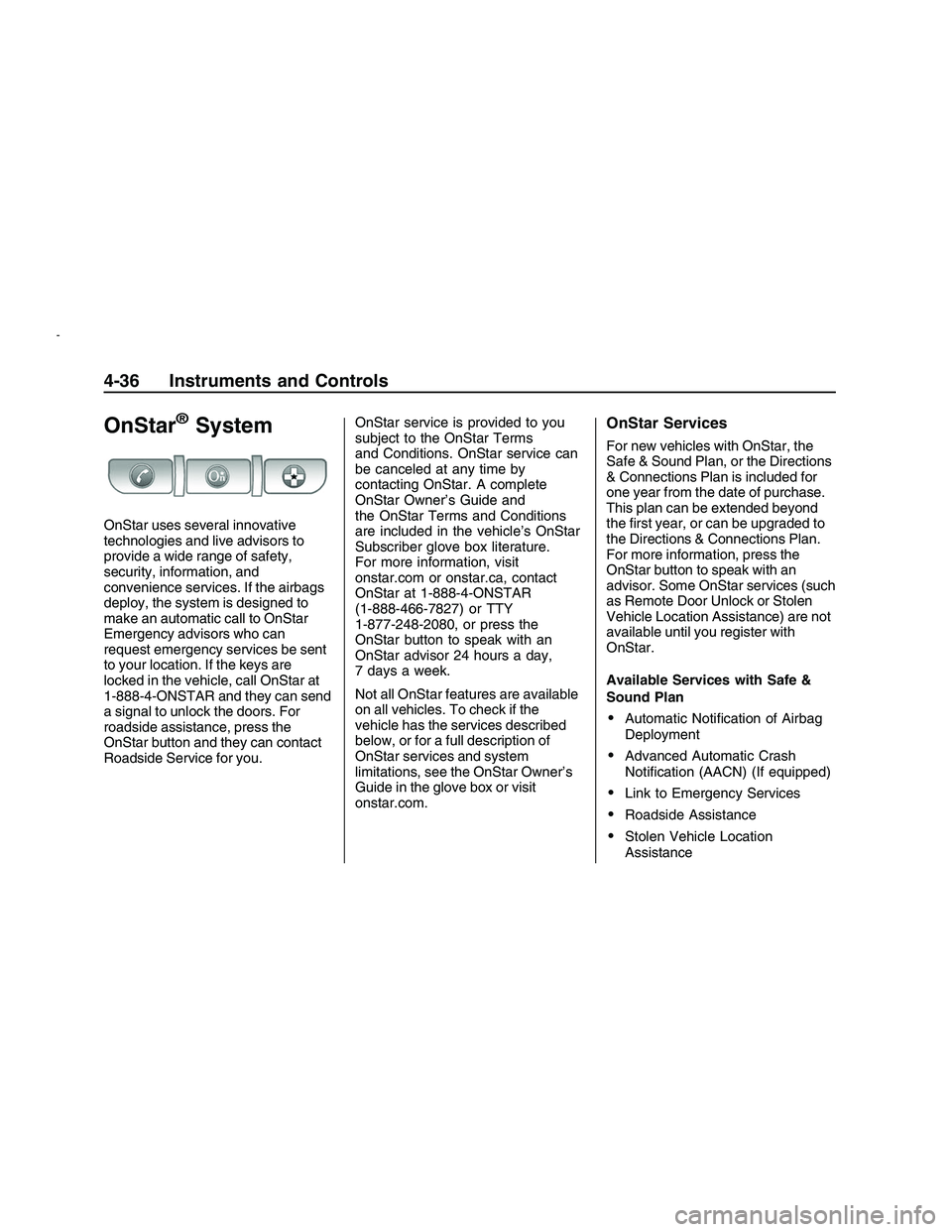
OnStar®System
OnStar uses several innovative
technologies and live advisors to
provide a wide range of safety,
security, information, and
convenience services. If the airbags
deploy, the system is designed to
make an automatic call to OnStar
Emergency advisors who can
request emergency services be sent
to your location. If the keys are
locked in the vehicle, call OnStar at
1-888-4-ONSTAR and they can send
a signal to unlock the doors. For
roadside assistance, press the
OnStar button and they can contact
Roadside Service for you.OnStar service is provided to you
subject to the OnStar Terms
and Conditions. OnStar service can
be canceled at any time by
contacting OnStar. A complete
OnStar Owner’s Guide and
the OnStar Terms and Conditions
are included in the vehicle’s OnStar
Subscriber glove box literature.
For more information, visit
onstar.com or onstar.ca, contact
OnStar at 1-888-4-ONSTAR
(1-888-466-7827) or TTY
1-877-248-2080, or press the
OnStar button to speak with an
OnStar advisor 24 hours a day,
7 days a week.
Not all OnStar features are available
on all vehicles. To check if the
vehicle has the services described
below, or for a full description of
OnStar services and system
limitations, see the OnStar Owner’s
Guide in the glove box or visit
onstar.com.
OnStar Services
For new vehicles with OnStar, the
Safe & Sound Plan, or the Directions
& Connections Plan is included for
one year from the date of purchase.
This plan can be extended beyond
the �rst year, or can be upgraded to
the Directions & Connections Plan.
For more information, press the
OnStar button to speak with an
advisor. Some OnStar services (such
as Remote Door Unlock or Stolen
Vehicle Location Assistance) are not
available until you register with
OnStar.
Available Services with Safe &
Sound Plan
Automatic Noti�cation of Airbag
Deployment
Advanced Automatic Crash
Noti�cation (AACN) (If equipped)
Link to Emergency Services
Roadside Assistance
Stolen Vehicle Location
Assistance
4-36 Instruments and Controls
2008 - Pontiac G8 Owner Manual
Page 142 of 334

Air Delivery Mode Control
Use the right knob to select from
the following modes.
0(Vent):Air is directed to the
instrument panel outlets.
1(Bi-Level):Air is divided
between the instrument panel
outlets and the �oor outlets.
d(Floor):Air is directed to the
�oor outlets with some air directed to
the windshield and side window
outlets.
4(Defog):Air is directed to the
windshield, �oor outlets, and
side window vents. Use this mode
to clear the windows of fog or
moisture and warm the passengers.
5(Defrost):Air is directed to
the windshield, with some air
directed to the side window vents.
Use this mode to quickly remove
fog or frost from the windshield.When defrost is selected, the air
conditioning turns on automatically
to improve defrosting performance.
In this mode the air conditioning
cannot be turned off and the
recirculation mode cannot be
turned on.
Air Conditioning
#(Air Conditioning):Press to
turn on or off. An indicator comes on
when the air conditioning is on.
The fan must be on to use the
air conditioning.
The air conditioning cannot be turned
off in defrost mode. If
#is pressed,
the indicator light �ashes three times
and the air conditioning stays on.
For quick cool down on hot days,
select the following settings together:
1. Press
#to turn on the air
conditioning.
2. Press
/to turn on the
recirculation.3. Select the coolest temperature
and highest fan speed.
4. Open the windows brie�y to
let hot air escape and then
close them.
5. Once the vehicle’s interior cools
down, turn off the recirculation,
and select
0. This maintains
the best comfort level during
extended driving.
The air conditioning system removes
moisture from the air, so a small
amount of water might drip under the
vehicle while idling or after turning off
the engine. This is normal.
The air conditioning should be
turned on for at least �ve to
ten minutes once every two weeks
to lubricate the air conditioning
seals, even in the winter.
7-2 Climate Controls
2008 - Pontiac G8 Owner Manual
Page 144 of 334
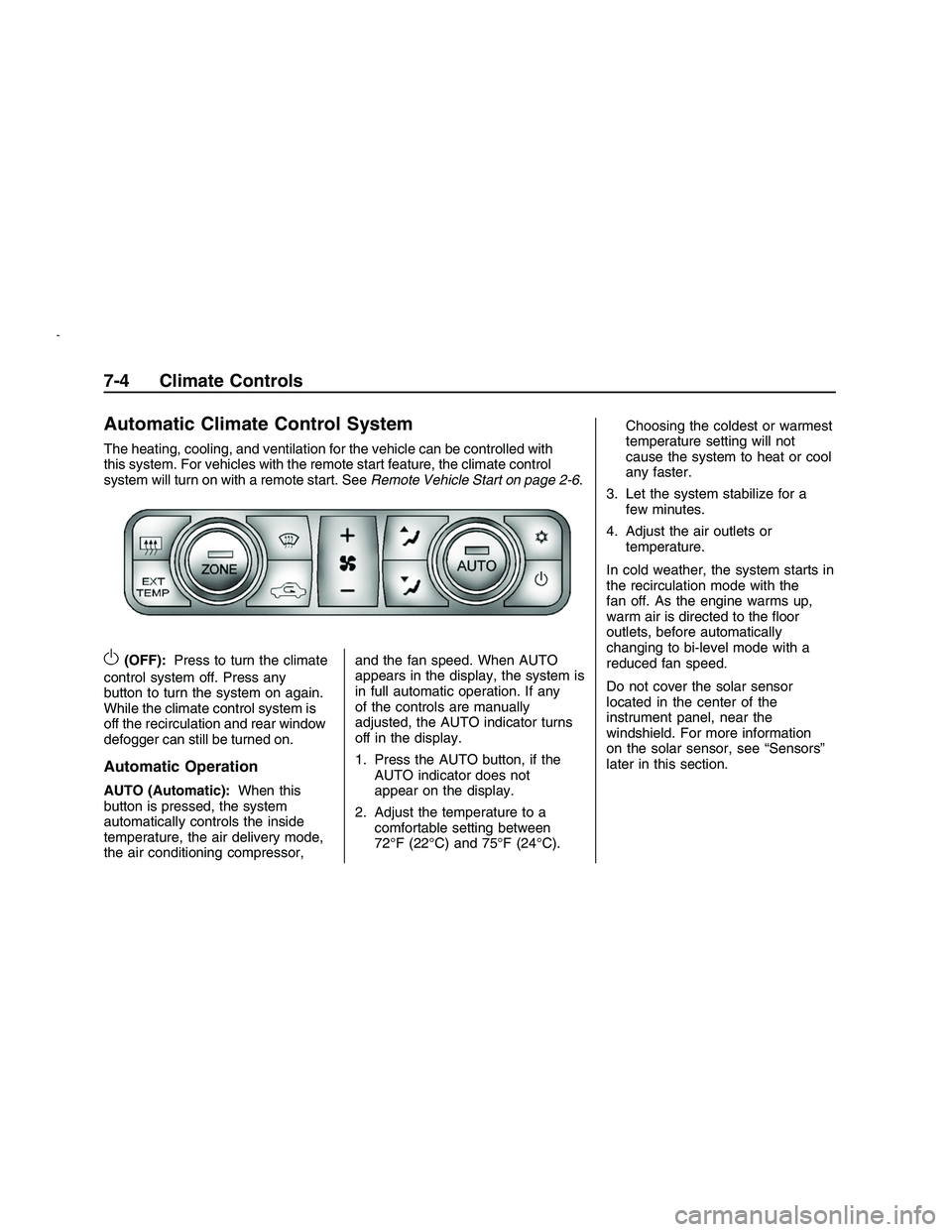
Automatic Climate Control System
The heating, cooling, and ventilation for the vehicle can be controlled with
this system. For vehicles with the remote start feature, the climate control
system will turn on with a remote start. SeeRemote Vehicle Start on page 2-6.
O(OFF):Press to turn the climate
control system off. Press any
button to turn the system on again.
While the climate control system is
off the recirculation and rear window
defogger can still be turned on.
Automatic Operation
AUTO (Automatic): When this
button is pressed, the system
automatically controls the inside
temperature, the air delivery mode,
the air conditioning compressor, and the fan speed. When AUTO
appears in the display, the system is
in full automatic operation. If any
of the controls are manually
adjusted, the AUTO indicator turns
off in the display.
1. Press the AUTO button, if the
AUTO indicator does not
appear on the display.
2. Adjust the temperature to a comfortable setting between
72°F (22°C) and 75°F (24°C). Choosing the coldest or warmest
temperature setting will not
cause the system to heat or cool
any faster.
3. Let the system stabilize for a few minutes.
4. Adjust the air outlets or temperature.
In cold weather, the system starts in
the recirculation mode with the
fan off. As the engine warms up,
warm air is directed to the �oor
outlets, before automatically
changing to bi-level mode with a
reduced fan speed.
Do not cover the solar sensor
located in the center of the
instrument panel, near the
windshield. For more information
on the solar sensor, see “Sensors”
later in this section.
7-4 Climate Controls
2008 - Pontiac G8 Owner Manual
Page 146 of 334
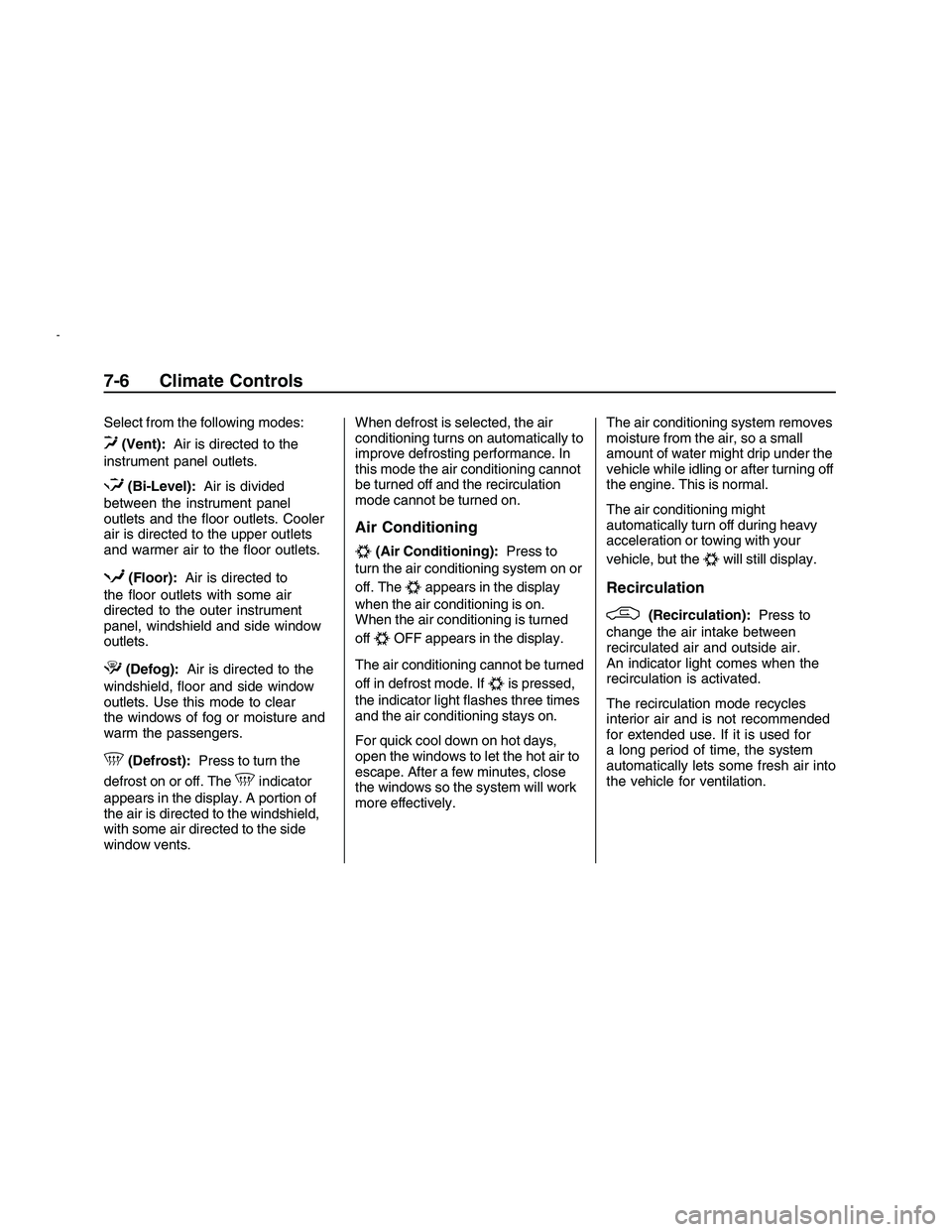
Select from the following modes:
0(Vent):Air is directed to the
instrument panel outlets.
1(Bi-Level):Air is divided
between the instrument panel
outlets and the �oor outlets. Cooler
air is directed to the upper outlets
and warmer air to the �oor outlets.
d(Floor):Air is directed to
the �oor outlets with some air
directed to the outer instrument
panel, windshield and side window
outlets.
4(Defog):Air is directed to the
windshield, �oor and side window
outlets. Use this mode to clear
the windows of fog or moisture and
warm the passengers.
5(Defrost):Press to turn the
defrost on or off. The
5indicator
appears in the display. A portion of
the air is directed to the windshield,
with some air directed to the side
window vents.When defrost is selected, the air
conditioning turns on automatically to
improve defrosting performance. In
this mode the air conditioning cannot
be turned off and the recirculation
mode cannot be turned on.
Air Conditioning
#(Air Conditioning):Press to
turn the air conditioning system on or
off. The
#appears in the display
when the air conditioning is on.
When the air conditioning is turned
off
#OFF appears in the display.
The air conditioning cannot be turned
off in defrost mode. If
#is pressed,
the indicator light �ashes three times
and the air conditioning stays on.
For quick cool down on hot days,
open the windows to let the hot air to
escape. After a few minutes, close
the windows so the system will work
more effectively.The air conditioning system removes
moisture from the air, so a small
amount of water might drip under the
vehicle while idling or after turning off
the engine. This is normal.
The air conditioning might
automatically turn off during heavy
acceleration or towing with your
vehicle, but the
#will still display.
Recirculation
/(Recirculation):Press to
change the air intake between
recirculated air and outside air.
An indicator light comes when the
recirculation is activated.
The recirculation mode recycles
interior air and is not recommended
for extended use. If it is used for
a long period of time, the system
automatically lets some fresh air into
the vehicle for ventilation.
7-6 Climate Controls
2008 - Pontiac G8 Owner Manual